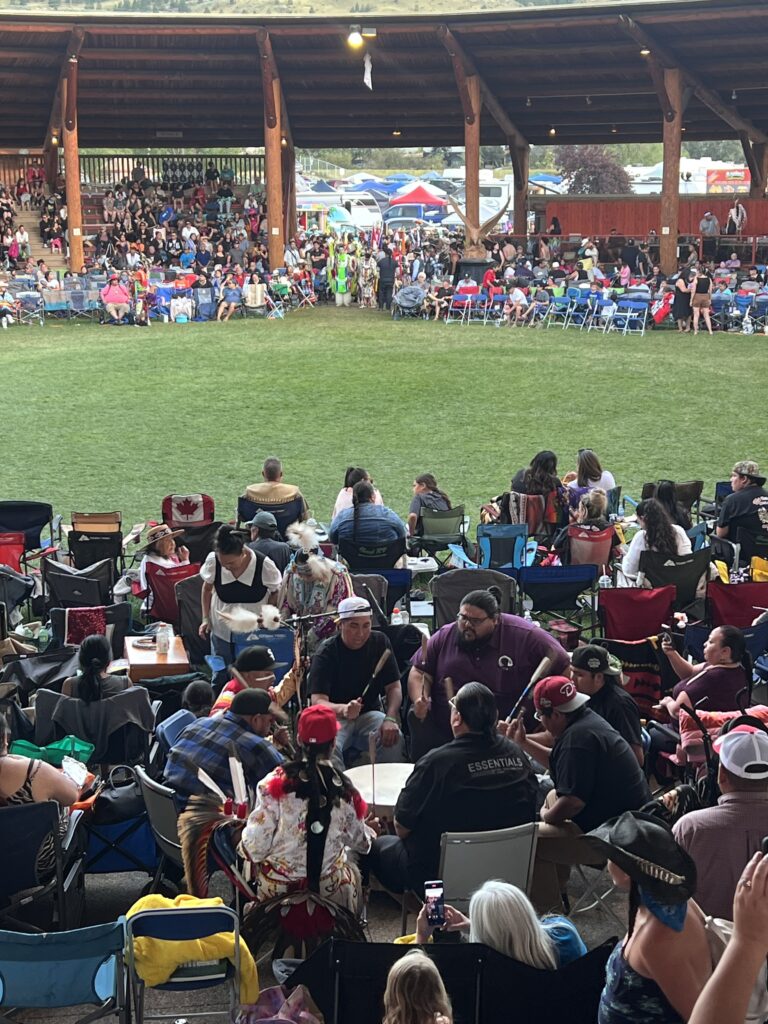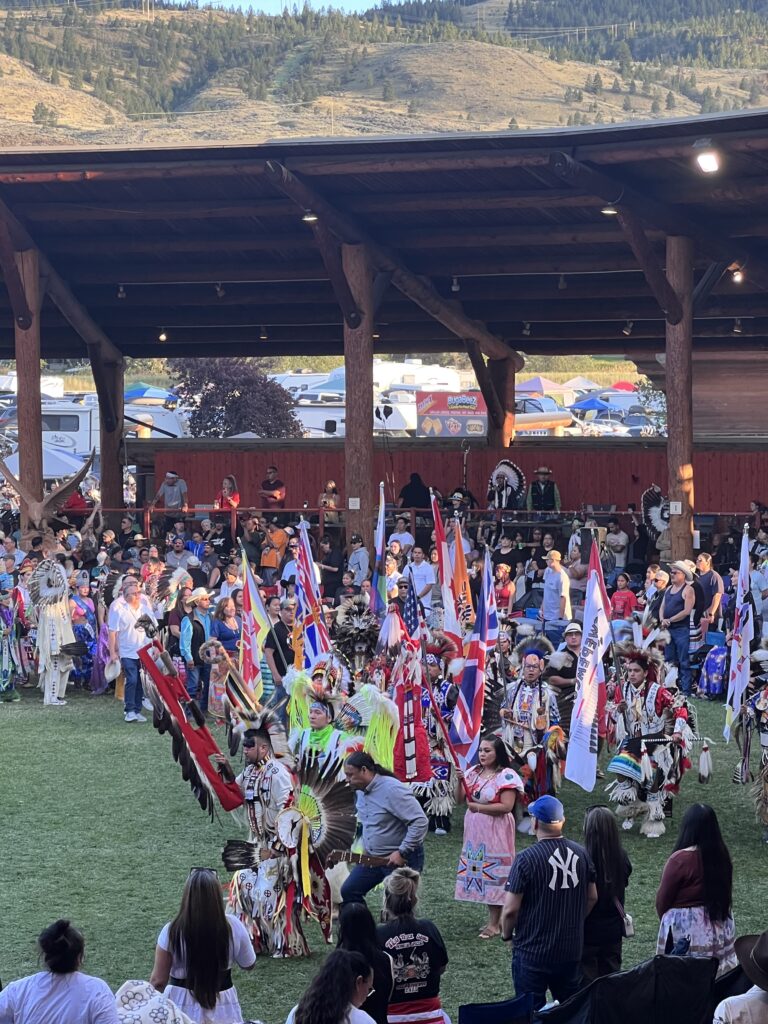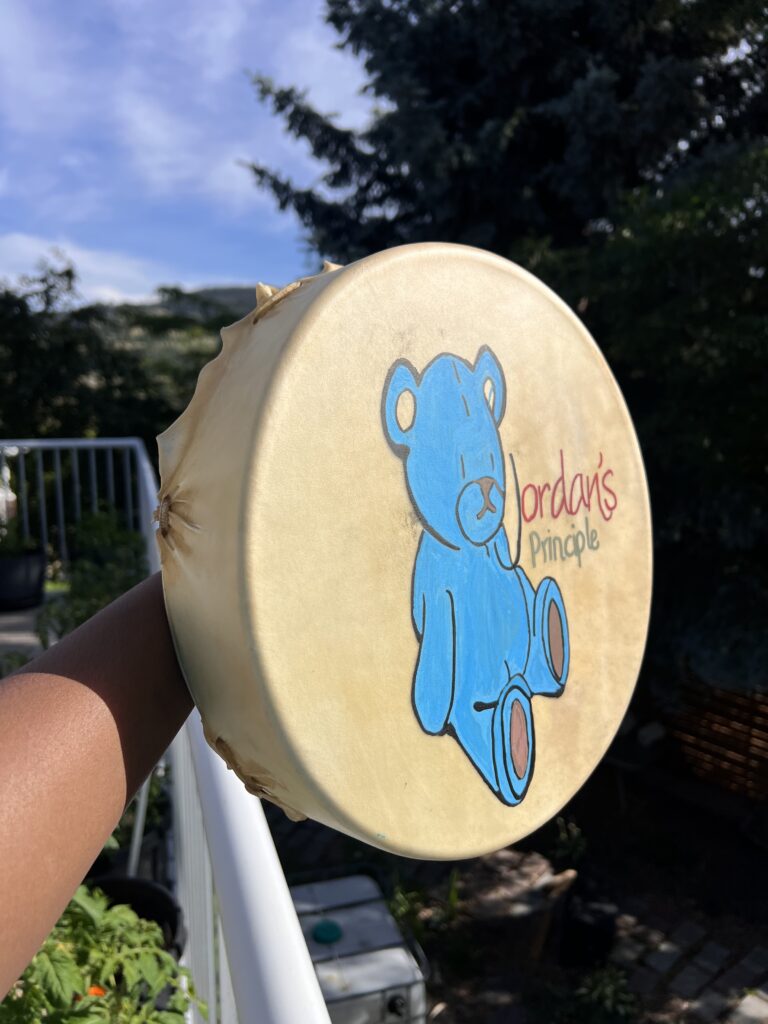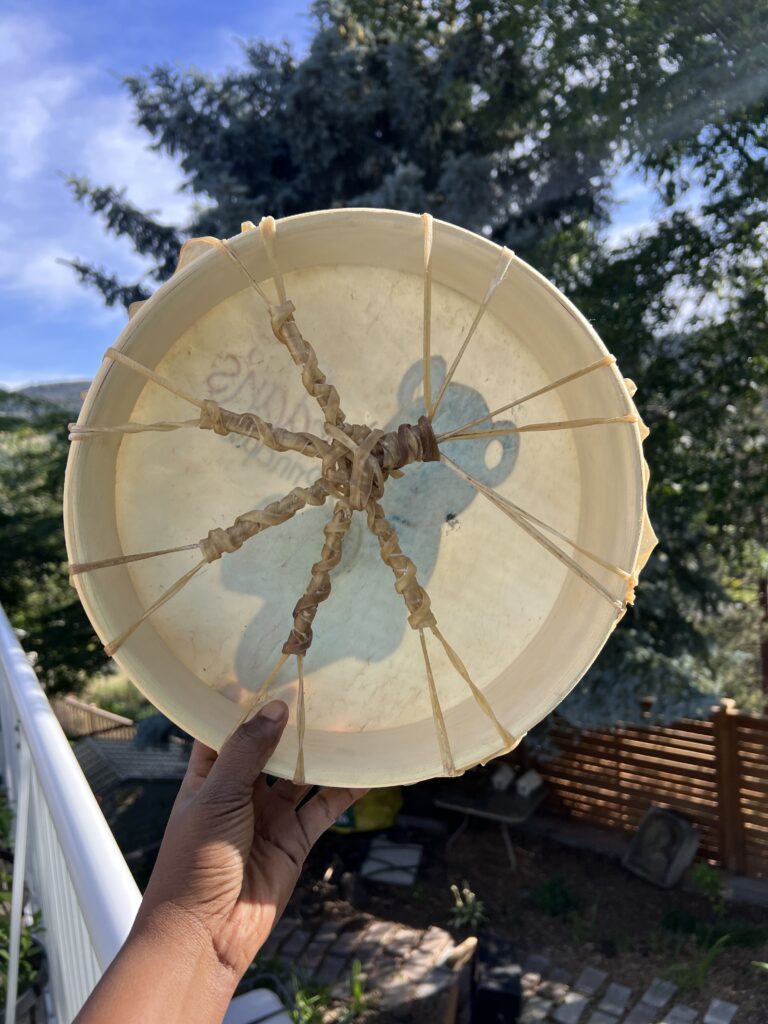During my practicum at Secwepemc Child and Family Services, I served as a member of the Cultural Integration Team. Our primary goal was to help the Indigenous communities in the seven communities reconnect with their language, culture, and traditions. Because of the invasion and the effects of residential schools on many generations, many people in the community have lost touch with their ancestorial values. By planning cultural classes, events, and hands-on learning opportunities, the Cultural Team brings these lost things back to life. Some of these activities included making drums, sewing moccasins and ribbon skirts, playing traditional games, learning their native language, and learning about their culture.
Being on this team gave me the opportunity to work directly with Secwepemc people of all ages. Our goal was the same whether we were working with foster children or people from the community. This was to help them reconnect with who they were. Every work we did had something to do with helping the community heal and gain strength. Besides, my job was not only to help plan events, but I also had to participate and learn from the community. I learned a lot about how culture can be used to boost confidence, pride, and a sense of connection. This made the experience very important to me.
Program Learning Outcome (PLO) Development
There are three main outcomes I wanted to learn at the start of my practicum. One was how to better communicate with people from other cultures. I also wanted to learn more about Indigenous knowledge systems and how to deal with problems of justice in real community settings in a creative way. I selected these goals because they fit with the main ideas of the HRSJ program and address the real needs of the community I was serving. I believe I made a lot of progress in all three areas. To communicate with people from other cultures, I had to change how I talked and carried myself all the time to fit the local values. For instance, when I worked with Elders or planned events, I learned to listen more than talk. I decided to ask before I did something, and I always respect customs. I discovered that being polite is not just what you say. This is also how you act, how you show up, and how you react when someone criticizes you. I had read about this kind of awareness in class, but it became much clearer when I used it.
Along with working on the practicum, I also tried to learn more about Indigenous knowledge and wisdom. As someone from Ghana, this was a subject that really interested me. I saw some connections between the ways my culture has always done things and what I was learning from the Secwepemc communities. Some of the things that made me think of my own life were the respect for Elders, the use of stories, and the spiritual value of nature. A lot of the things I did were new to me, though. For example, I had never attended a ceremony where drums were made, or traditional clothes were being sewn. During these times, I paid close attention, asked questions when it made sense, and always ensured that I learned carefully. What I liked about the group was how willing they were to share with me, even though I was from a different background.
Additionally, I ensured that their opinions and suggestions were a part of everything I did. For example, I did not just take part, but I also listened, watched, and changed how I was acting when I needed to. I also learned that books are not the only source of knowledge. Land, song, craft, and silence are also good places to learn. As time passed, I began to understand that restoring culture is not just about teaching, but also about promoting fairness and equality. In fact, it is more about getting back what was taken and making room for people to respect the Indigenous ways of life. Lastly, my third goal was to come up with creative ways to make things fair and just. Near the end of my practicum, I felt like I was making a slight difference in healing the wounds of colonization. I could feel this because we had developed some cultural programs. A lot of these Indigenous people we worked with had lost touch with their roots. Therefore, I thought of doing some small activities, such as helping a child make a ribbon vest or dancing at a Pow Wow. This was not just fun but was also a way to rebuild my personality little by little.
Workplace Orientation
I was given an official orientation when I first got to Secwepemc Child and Family Services. I went through the needed background check with the police. After that, I was given a tour of the entire agency. I also received a package for new employees that had information about the organization’s history, purpose, values, and the various departments. During those first few days, everyone I met was very friendly and open. Therefore, right from the start, I felt safe and supported with everyone around me.
Understanding Human Rights and Social Justice
It was a great experience working with the Cultural Integration Team because it helped me learn more about human rights and social justice in Canada. This is especially true when it comes to Indigenous problems. Before this, most of what I knew about these people came from reading books and listening to class lessons. But seeing how they work in real groups made me more aware of them. I learned that having a culture is a right of every person. I learned that many Indigenous groups are still working to get back the right to speak their language. With all these, they can pass on their traditions and live their lives according to their own beliefs.
One key thing I learn was that the Secwepemc people always put the needs of the people first. Therefore, our culture team did everything based on what they wanted, not what we thought was best for them. During this time, I helped plan and attend events such as language classes, cultural games, and sessions on how to wear traditional clothing. These events all showed me how culture and human rights are linked. I now understand that the fight to preserve culture and protect it is part of a larger struggle for fairness, respect, and honor.
Additionally, as I interacted with various Secwepemc Nation groups, I learned about the seven Indigenous communities in the area. These were Adams Lake, Whispering Pines/Clinton, North Thompson, Neskonlith, Skeetchestn, Bonaparte, and Kamloops Indian Bands. They are all working together to rebuild what was lost, and each has its strengths and weaknesses. I felt like everything we learned in class came to life when I learned their names, listened to their stories, and took part in their events.
AHA Moment
I had one of my most powerful “Aha!” moments at the weekly culture sessions, especially the workshop where we made drums. We would go to one of the seven communities every Tuesday and teach people how to make traditional drums, bead hats, and paint their finished items. Secondly, children under foster care would come to the agency every Wednesday, and we would play cultural games like LEHAL, make vests, dance Pow Wows, and sing native songs. I felt something change in me the first time I made my drum. I was not just watching or helping, but I was truly a part of it. That drum was very important to me because it made me feel like I was a part of something important, and that culture can heal.
Networking
At Secwepemc Child and Family Services, I was also able to make connections that meant a lot to me. I remember meeting the family roots worker who took people’s DNA and helped them trace their ancestors. That was one of the most memorable experiences I have had during this practicum. I believe that the effect of the residential schools put a lot of Indigenous people in different places around Canada, and it is important for them to find their true home. I also got along well with the people who worked at the office. It was a friendly and open environment to work in, and I made an effort to meet people from other departments. We ate, shared stories, and discussed many ideas. These little things helped me trust and feel like I belonged in this place. Therefore, networking was not just about my job, but also about getting to know people and respecting one another.
Challenges
I did not face any significant problems during my practicum. The orientation was clear, the team was helpful, and the supervisor explained my role well. Someone was always there to help me or answer my questions. I understand that many people think practicum stories have problems, but mine was a smooth and happy journey. I believe this is also because I was willing to learn and showed respect for the team I was joining.
Reflection and Future Plans
Now that I look back, I am proud of how much I have grown thanks to having the best supervisor and the best team. They excelled in their roles and genuinely cared about the people around them. Being in that setting taught me more than I thought it would, and I would not change a thing if I could. I am sure I want to continue working in community-based settings, particularly with groups that are fighting for justice and reclaiming their identity. On top of that, it made me remember that justice work is not always dramatic. In the quiet times, you might teach a child how to bead, listen to an Elder, or learn a song. That is where the change starts.
During my practicum at Secwepemc Child and Family Services, I served as a member of the Cultural Integration Team. Our primary goal was to help the Indigenous communities in the seven communities reconnect with their language, culture, and traditions. Because of the invasion and the effects of residential schools on many generations, many people in the community have lost touch with their ancestorial values. By planning cultural classes, events, and hands-on learning opportunities, the Cultural Team brings these lost things back to life. Some of these activities included making drums, sewing moccasins and ribbon skirts, playing traditional games, learning their native language, and learning about their culture.
Being on this team gave me the opportunity to work directly with Secwepemc people of all ages. Our goal was the same whether we were working with foster children or people from the community. This was to help them reconnect with who they were. Every work we did had something to do with helping the community heal and gain strength. Besides, my job was not only to help plan events, but I also had to participate and learn from the community. I learned a lot about how culture can be used to boost confidence, pride, and a sense of connection. This made the experience very important to me.
Program Learning Outcome (PLO) Development
There are three main outcomes I wanted to learn at the start of my practicum. One was how to better communicate with people from other cultures. I also wanted to learn more about Indigenous knowledge systems and how to deal with problems of justice in real community settings in a creative way. I selected these goals because they fit with the main ideas of the HRSJ program and address the real needs of the community I was serving. I believe I made a lot of progress in all three areas. To communicate with people from other cultures, I had to change how I talked and carried myself all the time to fit the local values. For instance, when I worked with Elders or planned events, I learned to listen more than talk. I decided to ask before I did something, and I always respect customs. I discovered that being polite is not just what you say. This is also how you act, how you show up, and how you react when someone criticizes you. I had read about this kind of awareness in class, but it became much clearer when I used it.
Along with working on the practicum, I also tried to learn more about Indigenous knowledge and wisdom. As someone from Ghana, this was a subject that really interested me. I saw some connections between the ways my culture has always done things and what I was learning from the Secwepemc communities. Some of the things that made me think of my own life were the respect for Elders, the use of stories, and the spiritual value of nature. A lot of the things I did were new to me, though. For example, I had never attended a ceremony where drums were made, or traditional clothes were being sewn. During these times, I paid close attention, asked questions when it made sense, and always ensured that I learned carefully. What I liked about the group was how willing they were to share with me, even though I was from a different background.
Additionally, I ensured that their opinions and suggestions were a part of everything I did. For example, I did not just take part, but I also listened, watched, and changed how I was acting when I needed to. I also learned that books are not the only source of knowledge. Land, song, craft, and silence are also good places to learn. As time passed, I began to understand that restoring culture is not just about teaching, but also about promoting fairness and equality. In fact, it is more about getting back what was taken and making room for people to respect the Indigenous ways of life. Lastly, my third goal was to come up with creative ways to make things fair and just. Near the end of my practicum, I felt like I was making a slight difference in healing the wounds of colonization. I could feel this because we had developed some cultural programs. A lot of these Indigenous people we worked with had lost touch with their roots. Therefore, I thought of doing some small activities, such as helping a child make a ribbon vest or dancing at a Pow Wow. This was not just fun but was also a way to rebuild my personality little by little.
Workplace Orientation
I was given an official orientation when I first got to Secwepemc Child and Family Services. I went through the needed background check with the police. After that, I was given a tour of the entire agency. I also received a package for new employees that had information about the organization’s history, purpose, values, and the various departments. During those first few days, everyone I met was very friendly and open. Therefore, right from the start, I felt safe and supported with everyone around me.
Understanding Human Rights and Social Justice
It was a great experience working with the Cultural Integration Team because it helped me learn more about human rights and social justice in Canada. This is especially true when it comes to Indigenous problems. Before this, most of what I knew about these people came from reading books and listening to class lessons. But seeing how they work in real groups made me more aware of them. I learned that having a culture is a right of every person. I learned that many Indigenous groups are still working to get back the right to speak their language. With all these, they can pass on their traditions and live their lives according to their own beliefs.
One key thing I learn was that the Secwepemc people always put the needs of the people first. Therefore, our culture team did everything based on what they wanted, not what we thought was best for them. During this time, I helped plan and attend events such as language classes, cultural games, and sessions on how to wear traditional clothing. These events all showed me how culture and human rights are linked. I now understand that the fight to preserve culture and protect it is part of a larger struggle for fairness, respect, and honor.
Additionally, as I interacted with various Secwepemc Nation groups, I learned about the seven Indigenous communities in the area. These were Adams Lake, Whispering Pines/Clinton, North Thompson, Neskonlith, Skeetchestn, Bonaparte, and Kamloops Indian Bands. They are all working together to rebuild what was lost, and each has its strengths and weaknesses. I felt like everything we learned in class came to life when I learned their names, listened to their stories, and took part in their events.
AHA Moment
I had one of my most powerful “Aha!” moments at the weekly culture sessions, especially the workshop where we made drums. We would go to one of the seven communities every Tuesday and teach people how to make traditional drums, bead hats, and paint their finished items. Secondly, children under foster care would come to the agency every Wednesday, and we would play cultural games like LEHAL, make vests, dance Pow Wows, and sing native songs. I felt something change in me the first time I made my drum. I was not just watching or helping, but I was truly a part of it. That drum was very important to me because it made me feel like I was a part of something important, and that culture can heal.
Networking
At Secwepemc Child and Family Services, I was also able to make connections that meant a lot to me. I remember meeting the family roots worker who took people’s DNA and helped them trace their ancestors. That was one of the most memorable experiences I have had during this practicum. I believe that the effect of the residential schools put a lot of Indigenous people in different places around Canada, and it is important for them to find their true home. I also got along well with the people who worked at the office. It was a friendly and open environment to work in, and I made an effort to meet people from other departments. We ate, shared stories, and discussed many ideas. These little things helped me trust and feel like I belonged in this place. Therefore, networking was not just about my job, but also about getting to know people and respecting one another.
Challenges
I did not face any significant problems during my practicum. The orientation was clear, the team was helpful, and the supervisor explained my role well. Someone was always there to help me or answer my questions. I understand that many people think practicum stories have problems, but mine was a smooth and happy journey. I believe this is also because I was willing to learn and showed respect for the team I was joining.
Reflection and Future Plans
Now that I look back, I am proud of how much I have grown thanks to having the best supervisor and the best team. They excelled in their roles and genuinely cared about the people around them. Being in that setting taught me more than I thought it would, and I would not change a thing if I could. I am sure I want to continue working in community-based settings, particularly with groups that are fighting for justice and reclaiming their identity. On top of that, it made me remember that justice work is not always dramatic. In the quiet times, you might teach a child how to bead, listen to an Elder, or learn a song. That is where the change starts.




